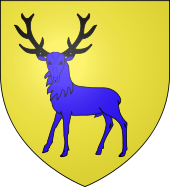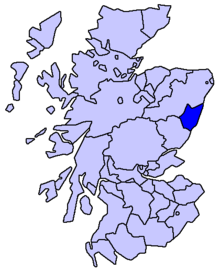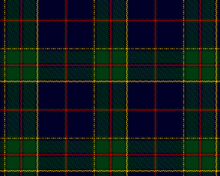- Clan Strachan
-
Clan Strachan Crest badge Crest: A demi stag springing Or holding a thistle in his mouth Proper Motto: NON TIMEO SED CAVEO Slogan: Clachnaben War cry: Clachnaben! Profile Region Highlands District Strachan District, in present day Aberdeenshire Gaelic name Strathaen Chief Clan Strachan has no chief, and is an armigerous clan 
Arms of the last Chief of Clan Strachan Last Chief: Sir Richard Strachan 6th Baronet of Thornton Died: 1828 Clan Strachan is a Scottish clan originating from Aberdeenshire. The clan does not currently have a chief, therefore it is treated as an Armigerous clan.[1]
The Clan Strachan warcry–slogan is Clachnaben!
Contents
Highland Clan
The Highland Boundary Fault is a geologic fault that traverses Scotland from Arran and Helensburgh on the west coast to Stonehaven in the east. It separates two distinctly different physiographic regions: the Highlands from the Lowlands, but in most places it is only recognisable as a change in topography. The Strachan District (or Strachan, Aberdeenshire aka the original Strachan lands and home of all Strachans) is located in Aberdeenshire some 15 miles northeast of Stonehaven, north of the Highland Boundary Fault, and is therefore properly recognized as a Scottish Highland clan. A few websites and various unofficial sources mistakenly purport that Clan Strachan is a Lowland clan, possibly because one of the Strachan castles (Thornton Castle) is located in Kincardineshire, just south of the Highland Boundary Fault in Laurencekirk (Strachan occupied 1348–1687). However, the noble Houses of Strachan (Thornton, Glenkindie, Lenturk, Carmyllie, and the Barony in Aberdeenshire) all originated from the pre-feudal Earldom (post-feudal Barony) of Strachan (aka the Strachan District). In addition to the location of the Strachan District being in the Royal Deeside Grampian Highlands of Scotland, which is well north of the Highland boundary, the other chiefly Houses of Strachan of equal stature to the House of Thornton were all located well north of the Highland Boundary Fault (e.g. Strachans of Glenkindie, Strachans of Lenturk). The Strachans of Glenkindie have occupied Glenkindie Castle, (and later, Glenkindie House) far longer than their Strachan cousins occupied Thornton Castle. In fact, the last chief of Clan Strachan, Bart. Admiral Sir Richard John Strachan, RN never stepped foot inside Thornton Castle. Although the family retained the Barony of Thornton, the property itself had been sold (in 1687) some 140 years prior to his death in 1828. Sir Richard, his wife and children settled in London after he retired from the Royal Navy. At the age of sixty-seven, Sir Richard John Strachan died at his residence, in Bryanstone-square, London, after a short illness, on 3 February 1828. Sir Richard's death, with no male heir, marked the definitive end of a dynasty that had lasted nearly 500 years.[2]
History
 Map of Scotland showing the district of Kincardineshire, where the Strachans of Thornton lived
Map of Scotland showing the district of Kincardineshire, where the Strachans of Thornton lived
Origins
Walderus de Stratheihen made a grant of lands to the church of St Andrews in 1200. The charter permitted the pastor to hunt on Strachan lands, to graze 60 pigs, 60 cows, and 20 horses on pastures between the Rivers Feugh and Dee and to obtain timber from the Wood of Goach (which to this day forms the northern part of the village of Strachan). In return for this, prayers were to be said for the souls of Waldeve and his ancestors, and he was to be buried at the priory. This grant pertains to the lands currently located on the present-day village of Strachan in Aberdeenshire, and subsequently ties the ‘de Strachan’ family directly to the barony of Strachan.[3]
John, son of Rudolph de Strachane, gave the lands to the Abbey of Dunfermline which was confirmed by a charter of King Alexander III of Scotland in 1278.
The barony of Strachan and the lands of Feteresso passed to the Clan Keith family from the Strachans by marriage, in the reign of King David II of Scotland, but Sir James Strachan of Monboddo obtained the lands of Thornton in Kincardine. He had two sons the elder, Duncan, took the lands of Monboddo, while the younger had the lands of Thornton.[4]
17th century and Civil War
Sir Alexander Strachan of Thornton was created a Baronet of Nova Scotia by King Charles I in 1625. The baronetcy passed in to the senior line of Monboddo by a charter under the great seal in 1663.
During the Civil War, the chief, Colonel Archibald Strachan, led a body of dragoons from Clan Strachan at the Battle of Carbisdale in 1650, where he held command under General Sir David Leslie on the side of the Covenanters. They were victorious against the Royalist army of James Graham, 1st Marquess of Montrose.
In 1654, Chief Sir James Strachan, 3rd baronet and 17th laird, married his 16-year-old cousin Elizabeth Forbes of Waterton. Their son James Strachan married Barbara Forbes of Newton. He led the clan at the Battle of Killiecrankie on the side of John Graham, 1st Viscount of Dundee where he was killed. After his death to the estate passed into the successive ownership of three Forbes lairds and, in 1720, to Thomas Fullerton of Gallery, the initials of whose son, Phillip (Beau) Fullerton of the Dragoon Guards and of his wife Katharine Scott of Benholm embellish the gilded weather-vane on the keep.
Napoleonic Wars
In the 19th century, during the Napoleonic Wars, Admiral Sir Richard Strachan, 6th baronet from the direct line of the chieftainship of the Clan Strachan, commanded a squadron. On 2 November 1805, his squadron engaged four French battleships that had escaped from Lord Nelson's triumph at the Battle of Trafalgar. Sir Richard captured all four French vessels with little loss of British life. He was created a Knight of the Bath and in 1810 was granted freedom of the City of London.
Present day
The last chief of Clan Strachan was one Admiral Sir Richard John Strachan (Bart.), RN, who died in 1828. As he was without male heir, his title and the baronetcy became dormant in 1854. To this day, the Strachan surname is recognized by the Court of the Lord Lyon, and the Standing Council of Scottish Chiefs as an Armigerous clan. The Clan Strachan Scottish Heritage Society recognizes Major Benjamin Strachan as the current head (or Patron) of the clan.[5] Benjamin and his wife Lize are the current owners of the Mill of Strachan Aberdeenshire.
Clan Castle
The last seat of the chief of Clan Strachan was at Thornton Castle.
The original Chief of Clan Strachan were the 'de Strachan' barons, whose lands included much of what is now the Royal Deeside area of the Grampian Highlands. In 1296, the barons ‘de Strachan’ were important local nobles until this time, when they backed the Earls of Buchan and Comyn (to whom they were probably related) in support of King John Balliol against Robert the Bruce. This culminated in the Battle of Inverurie in 1308, by whom they were defeated by the Bruce and disinherited. The barony 'de Strachan' passed to Bruce’s Great Chamberlain, Sir Alexander Fraser.
Fifty years later, at around 1350, shortly after King Robert's son and successor, David II, had been defeated and captured by the English, 1341, at the battle of Neville's Cross six descendants of the former Baron de Strachan received grants of lands and baronetcies.
- House of Glenkindie: Adam Strachan was granted lands in Aberdeenshire from William Keith (1350). William Keith had inherited the barony of Strachan through his mother, the daughter of Sir Alexander Fraser and niece of King Robert I. Adam Strachan also married the Daughter of the Earl of Mar, Margaret Mar, and gained the lands and baronetcy of Glenkindie. As a result of this marriage between the Strachan of Glenkindie and the Earldom of Mar, Strachans may wear the Tribe of Mar tartan. Additionally, as the Earldom of Mar were related to the King Robert the Bruce, descendants from this marriage would no doubt have royal blood. Glenkindie House
- House of Thornton: In 1348, seven years before Adam Strachan obtained Glenkindie, a Sir James Strachan of Monboddo married Agnete, heiress of the Barony of Thornton, which had been granted to her father by Robert I in 1309. From thenceforth, the Strachans of Thornton and the Strachans of Glenkindie became the two principal chieftains of the Strachan family. Thornton Castle lies about 15 miles to the south of the village of Strachan and Glenkindie House lies about 30 miles to its north. Thornton Castle
- House of Carmyllie: Alexander de Strachan granted the barony of Carmylie in Forfarshire (1347) by Sir Henry Maule (or Mauld) of Panmure. Also received the lands of Drummayeth, Hackmangerum, Acheyclare, and Moncur. Carmyllie Castle
- House of Lenturk: Sir John de Strachan was granted the barony of Lenturk in Aberdeenshire (1350 possibly by the Earl of Mar, as his lands were situated quite near to the Earl of Mar's fortress, Kildrummy Castle). In 1359, Sir John became Viscount (Sheriff) of Forfarshire. In official documents of the time, he is listed as a witness to the installation of John of Mar as Bishop of Aberdeen and, to another charter, as co-witness with William Keith, the Earl Marshall. In 1380, the granted the lands of Petgervy to his son Galfrid. Lenturk Castle
- Barony of Aberdeenshire: ~1347, King David II himself granted to Donald de Strachan and his wife Annabel very extensive lands in Forfarshire, and a barony in Aberdeenshire.
- House of Knock: Thomas de Strachan got the lands of Knock in Kincardineshire.
It is highly unlikely this is a coincidence, as all these grants occurred almost simultaneously, particularly as they involved marriages, and marriages amongst the nobility were almost invariably political. It follows that there must have been some new motivation that made marriage with the Strachans politically desirable.
It is believed by historians (see "Notes" immediately below) that the former Baron de Strachan was one of the large numbers of pro-Balliol nobles who, after the Battle of Inverurie (1308) fled to the English court, and where they were known as "the disinherited". But in 1347, King David, honouring obligations under the Franco-Scottish alliance, invaded the north of England, were heavily defeated, and captured by the English. So, from the perspective of “the disinherited", here was the son of the man (King Robert the Bruce) who had disinherited them arriving captive in London. If one king could disinherit them, why should not another? With a little persuasion King David reinstated the Strachans, among others.
NOTES:
1. Strachan, Major Benjamin, CMG. Author of "A History of the Strachans."
2. Strachan, James Andrew, FSA Scot. Author of "Here's Tae Us, Wha's Like Us – A History of Clan Strachan."Clan Septs
The Anglicization of the Gaelic led to different spellings of the name, as transliterations were made in various censuses: Strachan (mainly Scots), Straghan (mainly Irish), or Strahan (both) and Strawn (American).
See also
- Scottish clan
- Armigerous clan
- Strachan, Aberdeenshire
- Strachan Baronets
- Strachan
- Clan Strachan Book Store
- Standing Council of Scottish Chiefs
References
- ^ "Clan Status". clanstrachan.com. Archived from the original on 20 September 2007. http://web.archive.org/web/20070920173254/http://www.clanstrachan.com/heritage/clan.htm. Retrieved 20 February 2008.
- ^ Jim Strachan, Clan Strachan Scottish Heritage Society, author of Here's Tae Us, Wha's Like Us! A History of Clan Strachan.
- ^ Maj. Ben Strachan, author of "A History of the Strachans;" and Jim Strachan, FSA Scot, author of Here's Tae Us, Wha's Like Us! A History of Clan Strachan.
- ^ "SEE STRACHAN ARMORIAL BEARINGS". clanstrachan.com. http://www.clanstrachan.com/heritage/armigers/armiger_index.htm.
- ^ http://www.clanstrachan.org/clan_story.htm clanstrachan.org
External links
- Official Clan Strachan Society Website
- http://www.strachan-clan.net/
- http://www.strachan-clan.co.uk/
- http://www.clanchiefs.org/p/?init=clanfinder&id=strachan
- http://electricscotland.com/webclans/stoz/strachan2.html
- http://www.potts.net.au/tree/origin/strachan_name.html
- The Strachan, Straughn, Straughan, Strawn, Strawhen Family Website
Scottish clans Clans with chiefs Agnew · Anstruther · Arbuthnott · Arthur · Bannerman · Barclay · Borthwick · Boyd · Boyle · Brodie · Broun · Bruce · Buchan · Burnett · Cameron · Campbell · Carmichael · Carnegie · Cathcart · Charteris · Chattan · Chisholm · Cochrane · Colquhoun · Colville · Cranstoun · Crichton · Cumming · Darroch · Davidson · Dewar · Drummond · Dunbar · Dundas · Durie · Elliot · Elphinstone · Erskine · Farquharson · Fergusson · Forbes · Forsyth · Fraser · Fraser of Lovat · Gayre · Gordon · Graham · Grant · Gregor · Grierson · Guthrie · Haig · Haldane · Hamilton · Hannay · Hay · Henderson · Home · Hope · Hunter · Irvine · Jardine · Johnstone · Keith · Kennedy · Kerr · Kincaid · Lamont · Leask · Lennox · Leslie · Lindsay · Lockhart · Lumsden · Lyon · MacAlister · MacBain · MacDonald · Macdonald of Clanranald · MacDonald of Keppoch · Macdonald of Sleat · MacDonell of Glengarry · MacDougall · Macdowall · MacIntyre · Mackay · Mackenzie · Mackinnon · Mackintosh · Maclachlan · Maclaine of Lochbuie · MacLaren · MacLea (Livingstone) · Maclean · MacLennan · MacLeod · MacLeod of Lewis · MacMillan · Macnab · Macnaghten · MacNeacail · MacNeil · Macpherson · MacTavish · MacThomas · Maitland · Makgill · Malcolm (MacCallum) · Mar · Marjoribanks · Matheson · Menzies · Moffat · Moncreiffe · Montgomery · Morrison · Munro · Murray · Napier · Nesbitt · Nicolson · Ogilvy · Oliphant · Primrose · Ramsay · Rattray · Riddell · Robertson · Rollo · Rose · Ross · Ruthven · Sandilands · Scott · Scrymgeour · Sempill · Shaw · Sinclair · Skene · Spens · Stirling · Strange · Stuart of Bute · Sutherland · Swinton · Trotter · Urquhart · Wallace · Wedderburn · Wemyss · Wood ·
Armigerous clans Abercromby · Abernethy · Adair · Adam · Aikenhead · Ainslie · Aiton · Allardice · Anderson · Armstrong · Arnott · Auchinleck · Baillie · Baird · Balfour · Bannatyne · Baxter · Bell · Belshes · Bethune · Beveridge · Binning · Bissett · Blackadder · Blackstock · Blair · Blane · Blyth · Boswell · Brisbane · Buchanan · Butter · Byres · Cairns · Calder · Caldwell · Callender · Campbell of Breadalbane · Campbell of Cawdor · Carruthers · Cheyne · Chalmers · Clelland · Clephane · Cockburn · Congilton · Craig · Crawford · Crosbie · Cunningham · Dalmahoy · Dalrymple · Dalzell · Dennistoun · Don · Douglas · Duncan · Dunlop · Edmonstone · Fairlie · Falconer · Fenton · Fleming · Fletcher · Forrester · Fotheringham · Fullarton · Galbraith · Galloway · Gardyne · Gartshore · Ged · Gibsone · Gladstains · Glas · Glen · Glendinning · Gray · Gunn · Haliburton · Halkerston · Halket · Hepburn · Heron · Herries · Hogg · Hopkirk · Horsburgh · Houston · Hutton · Inglis · Innes · Kelly · Kinloch · Kinnaird · Kinnear · Kinninmont · Kirkcaldy · Kirkpatrick · Laing · Lammie · Langlands · Learmonth · Little · Logan · Logie · Lundin · Lyle · MacAulay · Macbrayne · MacDuff · MacEwen · MacFarlane · Macfie · Macgillivray · MacInnes · MacIver · Mackie · MacLellan · Macquarrie · Macqueen · Macrae · Masterton · Maule · Maxton · Maxwell · McCorquodale · McCulloch · McKerrell · Meldrum · Melville · Mercer · Middleton · Moncur · Monteith · Monypenny · Mouat · Moubray · Mow · Muir · Murray of Atholl · Nairn · Nevoy · Newlands · Newton · Norvel · Ochterlony · Orrock · Paisley · Paterson · Pennycook · Pentland · Peter · Pitblado · Pitcairn · Pollock · Polwarth · Porterfield · Preston · Pringle · Purves · Rait · Ralston · Renton · Roberton · Rossie · Russell · Rutherford · Schaw · Seton · Skirving · Somerville · Spalding · Spottiswood · Stewart · Stewart of Appin · Strachan · Straiton · Strange · Sydserf · Symmers · Tailyour · Tait · Tennant · Troup · Turnbull · Tweedie · Udny · Vans · Walkinshaw · Wardlaw · Watson · Wauchope · Weir · Whitefoord · Whitelaw · Wishart · Young
Culture and society Scotland · Clan chief · Septs · Clan badge · Clan crest · Clan battles · Tartan · Bagpipes · Clearances · Kilt · Manrent · The Highlands · Battle of Culloden · Highland games · Border Reivers · Scottish heraldry · Scottish surnames
Categories:- Scottish clans
- Armigerous clans
Wikimedia Foundation. 2010.

